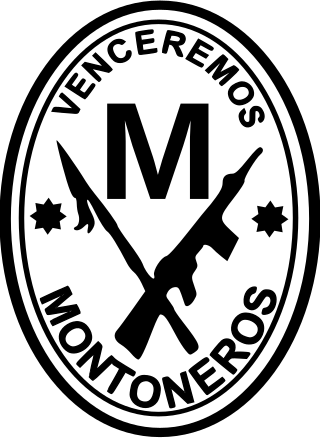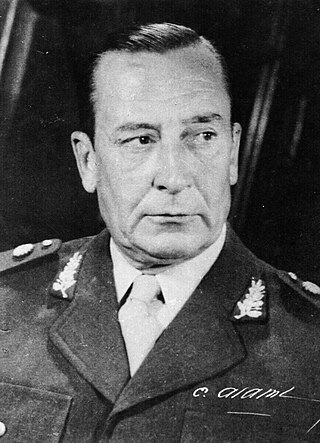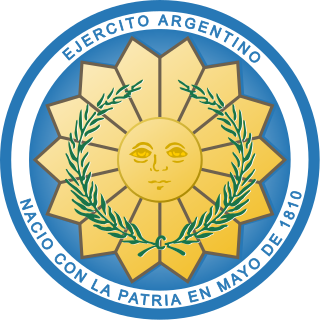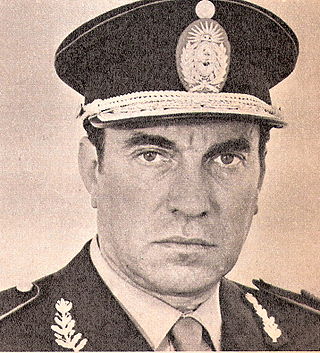
Montoneros was an Argentine far-left Peronist and Catholic revolutionary guerrilla organization, which emerged in the 1970s during the "Argentine Revolution" dictatorship. Its name was a reference to the 19th-century cavalry militias called Montoneras, which fought for the Federalist Party in the Argentine civil wars. Radicalized by the political repression of anti-Peronist regimes, the influence of Cuban Revolution and socialist worker-priests committed to liberation theology, the Montoneros emerged from the 1960s Catholic revolutionary guerrilla Comando Camilo Torres as a "national liberation movement", and became a convergence of revolutionary Peronism, Guevarism, and the revolutionary Catholicism of Juan García Elorrio shaped by Camilism. They fought for the return of Juan Perón to Argentina and the establishment of "Christian national socialism", based on 'indigenous' Argentinian and Catholic socialism, seen as the ultimate conclusion of Peronist doctrine.

Isabel Martínez de Perón is an Argentine politician who served as the 41st president of Argentina from 1974 to 1976. She was one of the first female republican heads of state in the world, and the first woman to serve as president of a country. Perón was the third wife of President Juan Perón. During her husband's third term as president from 1973 to 1974, she served as both the 29th vice president and first lady of Argentina. From 1974 until her resignation in 1985, she was also the 2nd President of the Justicialist Party.

Raúl Ricardo Alfonsín was an Argentine lawyer and statesman who served as President of Argentina from 10 December 1983 to 8 July 1989. He was the first democratically elected president after the 7-years National Reorganization Process. Ideologically, he identified as a radical and a social democrat, serving as the leader of the Radical Civic Union from 1983 to 1991, 1993 to 1995, 1999 to 2001, with his political approach being known as "Alfonsinism".

Pedro Eugenio Aramburu Silveti was an Argentine Army general who was the dictator of Argentina from November 13, 1955, to May 1, 1958. He was a major figure behind the Revolución Libertadora, the military coup against Juan Perón in 1955. He was kidnapped by the left-wing organization Montoneros on May 29, 1970, and then murdered as part of retaliation. He had been involved in the June 1956 execution of Army General Juan José Valle—associated with the Peronist movement— and 26 Peronist militants, after a botched attempt to overthrow his regime.

The Dirty War is the name used by the military junta or civic-military dictatorship of Argentina for its period of state terrorism in Argentina from 1974 to 1983. During this campaign, military and security forces and death squads in the form of the Argentine Anticommunist Alliance hunted down any political dissidents and anyone believed to be associated with socialism, left-wing Peronism, or the Montoneros movement.

The People's Revolutionary Army was the military branch of the communist Workers' Revolutionary Party in Argentina.
The Argentine Anticommunist Alliance was an Argentine Peronist and fascist political terrorist group operated by a sector of the Federal Police and the Argentine Armed Forces, linked with the anticommunist lodge Propaganda Due, that killed artists, priests, intellectuals, leftist politicians, students, historians and union members, as well as issuing threats and carrying out extrajudicial killings and forced disappearances during the presidencies of Juan Perón and Isabel Perón between 1973 and 1976. The group was responsible for the disappearance and death of between 700 and 1100 people.

The Argentine Army is the land force branch of the Armed Forces of the Argentine Republic and the senior military service of Argentina. Under the Argentine Constitution, the president of Argentina is the commander-in-chief of the Armed Forces. Command authority is exercised through the Minister of Defense.
The theory of the two demons is a rhetorical device used in Argentine political discourse to disqualify arguments that appear to morally equate violent political subversion with illegal repressive activities carried out by the state.

The Battle of San Lorenzo was fought on 3 February 1813 in San Lorenzo, Argentina, then part of the United Provinces of the Río de la Plata. The royalist troops were composed of militiamen recruited in Montevideo under the command of militia captain Antonio Zabala, who were defeated by the Regiment of Mounted Grenadiers under the command of José de San Martín. This battle was the baptism by fire for this military unit, as well as for San Martín in the Spanish American wars of independence.

Rodolfo Jorge Walsh was an Argentine writer and journalist of Irish descent, considered the founder of investigative journalism in Argentina. He is most famous for his Open Letter from a Writer to the Military Junta, which he published the day before his murder, protesting that Argentina's last civil-military dictatorship's economic policies were having an even greater and disastrous effect on ordinary Argentines than its widespread human rights abuses.

Operativo Independencia was a 1975 Argentine military operation in Tucumán Province to crush the People's Revolutionary Army (ERP), a Guevarist guerrilla group which tried to create a Vietnam-style war front in the northwestern province. It was the first large-scale military operation of the Dirty War.

Ítalo Argentino Luder was an Argentine Justicialist Party politician. As provisional president of the Argentine Senate, Luder served as the acting President of Argentina from 13 September 1975 until 16 October 1975, deputizing for Isabel Perón. Luder was also the Justicialist Party's 1983 presidential candidate, a National Deputy, one of Carlos Menem's defense ministers, and Argentina's ambassador to France.

The second Argentine general election of 1973 was held on 23 September.

Antonio Domingo Bussi was an army general during the military dictatorship in Argentina and a politician prominent in the recent history of Tucumán Province, Argentina. He was tried and convicted for crimes against humanity.
Juan Domingo Perón was an Argentine military officer and politician, who served three times as President of Argentina.
The expulsion of Montoneros from Plaza de Mayo was a key event of the third presidency of Juan Perón. It took place on May 1, 1974, during celebrations of International Workers' Day.

Argentine nationalism is the nationalism of Argentine people and Argentine culture. It surged during the War of Independence and the Civil Wars, and strengthened during the 1880s.
Events in the year 1974 in Argentina.
The Battle of Acheral was fought near the San Gabriel stream, some 3 km away from the small town of Acheral, Tucumán province, Argentina. It was a turning point in the Operativo Independencia, a domestic Argentine military intervention aimed at eradicating guerrilla activities in Tucumán province, as well as eliminating so-called subversive elements. This action received nationwide media coverage due to the presence of two journalists from Gente magazine at the time.














